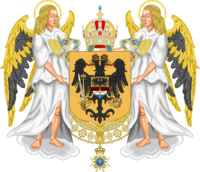Emperor of the Levantines: Difference between revisions
Created page with "{{wip}} The '''Emperor of the Levantines''', sometimes called '''Holy Levantine Emperor''' is a semi-defunct title of the ruler of the Holy Levantine Empire (considered by it..." Tag: 2017 source edit |
mNo edit summary |
||
| Line 1: | Line 1: | ||
{{wip}} | {{wip}} | ||
{{Infobox monarchy | |||
| royal_title = Emperor of the Levantines | |||
| realm = [[Urcea]] | |||
| coatofarms = DeWelutaNew.png | |||
| coatofarms_size = 200 | |||
| coatofarms_article = | |||
| image = Prince Carl Philip in January 2014.jpg | |||
| incumbent = [[Riordan VIII]] | |||
| incumbentsince = 14 August 2006 | |||
| style = His Most Christian Majesty | |||
| heir_apparent = [[Leo, Prince of Halfway]] | |||
| first_monarch = Conchobar I | |||
| date = <!--See above--> | |||
| residence = | |||
*[[Julian Palace]] (de jure) | |||
*[[Castle Welute]] (de facto) | |||
| appointer = {{wp|Hereditary}} | |||
| website = | |||
}} | |||
The '''Emperor of the Levantines''', sometimes called '''Holy Levantine Emperor''' is a semi-defunct title of the ruler of the Holy Levantine Empire (considered by itself to be the successor of Great Levantia) during the Middle Ages through the 20th Century. Prior to the Great War, the title was, without interruption, held in conjunction with title of King of Dericania and King of Culfra, and these two titles were considered to be the two constituent crowns of the Holy Levantine Empire. Though the Empire and its institutions came to a functional end during the Great War, the Empire, and thus the Emperor, have continued as a legal fiction in full union with the Urcean Crown. The terms of the title's continuance - and its possession by the Apostolic King of Urcea - are set forth in the Treaty of Corcra, the document that ended the South Levantine phase of the Great War. | |||
== See Also == | == See Also == | ||
| Line 25: | Line 27: | ||
[[Category: Urcea]] | [[Category: Urcea]] | ||
[[Category: | [[Category: Graphics Requested]] | ||
Revision as of 16:18, 7 September 2022
This article is a work-in-progress because it is incomplete and pending further input from an author. Note: The contents of this article are not considered canonical and may be inaccurate. Please comment on this article's talk page to share your input, comments and questions. |
| Emperor of the Levantines of Urcea | |
|---|---|
 | |
| Incumbent | |
 | |
| Riordan VIII since 14 August 2006 | |
| Details | |
| Style | His Most Christian Majesty |
| Heir apparent | Leo, Prince of Halfway |
| First monarch | Conchobar I |
| Residence |
|
| Appointer | Hereditary |
The Emperor of the Levantines, sometimes called Holy Levantine Emperor is a semi-defunct title of the ruler of the Holy Levantine Empire (considered by itself to be the successor of Great Levantia) during the Middle Ages through the 20th Century. Prior to the Great War, the title was, without interruption, held in conjunction with title of King of Dericania and King of Culfra, and these two titles were considered to be the two constituent crowns of the Holy Levantine Empire. Though the Empire and its institutions came to a functional end during the Great War, the Empire, and thus the Emperor, have continued as a legal fiction in full union with the Urcean Crown. The terms of the title's continuance - and its possession by the Apostolic King of Urcea - are set forth in the Treaty of Corcra, the document that ended the South Levantine phase of the Great War.
See Also
- List of Emperors of the Levantines